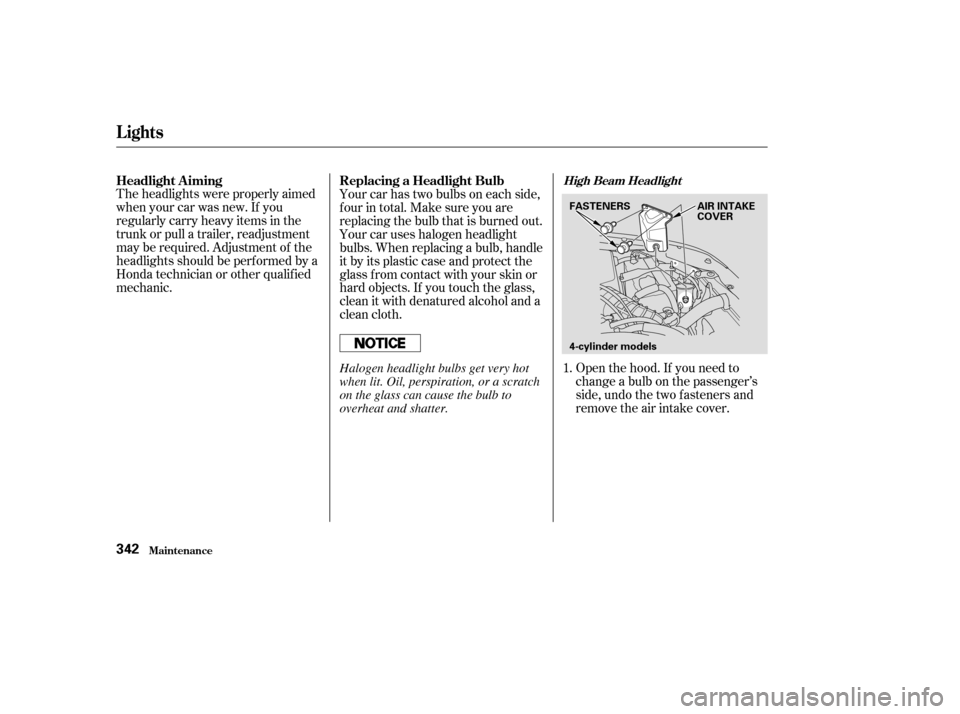Page 239 of 429

Distribute cargo evenly on the
f loor of the trunk, placing the
heaviest items on the bottom and
as f ar f orward as possible.
If youfolddownthebackseat,tie
down items that could be thrown
about the car during a crash or
sudden stop.
If you carry large items that
prevent you f rom closing the trunk
lid, exhaust gas can enter the
passenger area. To avoid the
possibility of, f ollow the instructions
on page .
Do not put any items on top of the
rear shelf . They can block your
view and be thrown around the car
during a crash.
If you can carry any items on a
roof rack, be sure the total weight
of the rack and the items does not
exceed the maximum allowable
weight. Please contact your Honda
dealer f or f urther inf ormation.
Be sure items placed on the f loor
behind the f ront seats cannot roll
under the seats and interf ere with
the driver’s ability to operate the
pedals, or with the proper
operation of the seats.
Keep the glove box closed while
driving. If it is open, a passenger
could injure their knees during a
crash or sudden stop. Store or secure all items that could
be thrown around and hurt
someone during a crash.
56
Carrying Cargo in the Trunk or on
a Roof T op Carrier
carbon monoxide
poisoning
Carrying Items in the Passenger
Compartment
Carrying Cargo
Bef ore Driving236
Page 240 of 429
The cargo net can be used to help
hold down items stored in the trunk.
To use the cargo net, hook it to the
buttons on the f loor and sides of the
trunk. You can use the cargo net in
several conf igurations by hooking it
to dif f erent buttons.
When you are not using the cargo
net,storeitinthesparetirewell.
There are hooks on the f loor and
sides of the trunk. They can be used
to install a net f or securing items.
On all EX and EX-V6 models
Carrying Cargo
Bef ore Driving
Cargo Net
T runk Hooks
237
Page 243 of 429

Make sure all windows, mirrors,
and outside lights are clean and
unobstructed. Remove f rost, snow,
or ice.
Check that the hood and trunk are
f ully closed.Check the adjustment of the seat
(see page ).
Check the adjustment of the
inside and outside mirrors (see
page ).
Check the adjustment of the
steering wheel (see page ).
Make sure the doors are securely
closed and locked.
Fasten your seat belt. Check that
your passengers have f astened
their seat belts (see page ).Turn the ignition switch ON (II).
Check the indicator lights in the
instrument panel.
Start the engine (see page ).
Check the gauges and indicator
lights in the instrument panel (see
page ).
Check that any items you may be
carrying with you inside are stored
properly or f astened down
securely. Visually check the tires. If a tire
looks low, use a gauge to check its
pressure.
Youshoulddothefollowingchecks
and adjustments every day bef ore
you drive your car.
3.2.
1.
4. 5.
6.
7.
8.
9. 11.
12. 10.
16 61
94
108 80 241
Preparing to Drive
Driving240
Page 256 of 429

�µMake sure the parking brake is f ully
released bef ore driving away.
Driving with the parking brake
partially set can overheat or damage
the rear brakes.
Always use the parking brake when
you park your car. The indicator on
the instrument panel shows that the
parking brake is not f ully released; it
does not indicate that the parking
brakeisfirmlyset.Makesurethe
parking brake is set f irmly or your
car may roll if it is parked on an
incline.
If your car has an automatic
transmission, set the parking brake
bef ore you put the transmission in
Park.Thiskeepsthecarfrom
moving and putting pressure on the
parking mechanism in the
transmission making it easier to
move the shift lever out of Park
when you want to drive away. If the car is f acing uphill, turn the
f ront wheels away f rom the curb. If
you have a manual transmission, put
it in f irst gear.
If the car is f acing downhill, turn the
f ront wheels toward the curb. If you
have a manual transmission, put it in
reverse gear.
Make sure the moonroof (if
equipped) and the windows are
closed.
Lockthedoorswiththekeyorthe
remote transmitter. Place any packages, valuables, etc.,
in the trunk or take them with you. Turn of f the lights.
Never park over dry leaves, tall
grass, or other f lammable
materials. The three way catalytic
converter gets very hot, and could
cause these materials to catch on
fire. Check the indicator on the
instrument panel to verif y that the
security system is set.
On cars with security system
Parking T ips
Parking
Driving253
Page 345 of 429

Theheadlightswereproperlyaimed
when your car was new. If you
regularly carry heavy items in the
trunk or pull a trailer, readjustment
may be required. Adjustment of the
headlights should be perf ormed by a
Honda technician or other qualif ied
mechanic.Your car has two bulbs on each side,
four in total. Make sure you are
replacing the bulb that is burned out.
Your car uses halogen headlight
bulbs. When replacing a bulb, handle
it by its plastic case and protect the
glass from contact with your skin or
hard objects. If you touch the glass,
clean it with denatured alcohol and a
clean cloth.
Open the hood. If you need to
change a bulb on the passenger’s
side, undo the two f asteners and
remove the air intake cover.
1.
Headlight A iming
Replacing a Headlight Bulb
Lights
Maint enance
High Beam Headlight
342
4-cylinder models FASTENERSAIR INTAKE
COVER
Halogen headlight bulbs get very hot
when lit. Oil, perspiration, or a scratch
on the glass can cause the bulb to
overheat and shatter.
Page 351 of 429
Open the trunk.
Remove the light assembly cover
by pulling its outside edge.Determine which of the three
bulbs is burned out: stop/taillight/
side marker, back-up or turn
signal.
Remove the socket by turning it
one-quarter turn counterclockwise.
Pull the bulb straight out of its
socket.
Push the new bulb straight into
the socket until it bottoms.
Reinstall the socket into the light
assembly by turning it clockwise
until it locks.
Turn on the lights to make sure
the new bulb is working.
Install the light assembly cover.
Make sure it snaps into place.
1. 3. 2.
4.
5.
6.
7.
Lights
Maint enance
Replacing Rear Bulbs
348
COVER
Page 352 of 429
Open the trunk.
Caref ully bend back the corner of
the trunk lid trim to expose the
bulbs. Remove the six trim clips f rom the
trunk lid trim by caref ully prying
them using a small, f lat-tipped
screwdriver.Remove the socket f rom the light
assembly by squeezing the tabs on
both sides of the socket.
Pull the bulb straight out of its
socket. Push the new bulb in until
it bottoms in the socket.Turn on the parking lights and
check that the new bulb is
working.
Reinstall the socket back in place
by pushing it in until it latches.
Reinstall the trunk lid trim. Make
sure it is installed under the edge
of the trunk lid seal.
Put each trim clip in the hole on
the trunk lid trim and push on the
center until it locks (the center is
flushwiththehead).
1.
2. 7.
8.
3.
4. 5.
6.
6-cylinder models
6-cylinder models
Lights
Maint enance
Replacing a Rear License Plate
Bulb
349
TRIM CLIPS
Page 353 of 429
Open the trunk and remove the
socket f rom the light assembly by
turning it one-quarter turn counter-
clockwise.
Remove the burned-out bulb by
pulling it straight out of the socket.
Install the new bulb in the socket.Reinstall the socket. Turn it clock-
wise until it locks.
Turn on the lights to make sure
the new bulb is working.
1. 2. 3.
4.
Replacing a High-mount Brake
Light Bulb
Lights
Maint enance350
BULB
SOCKET